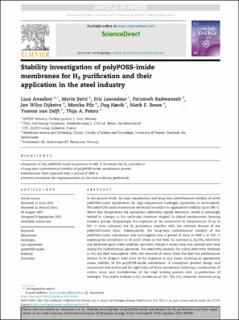| dc.contributor.author | Ansaloni, Luca | |
| dc.contributor.author | Saric, Maria | |
| dc.contributor.author | Eric, Louradour | |
| dc.contributor.author | Farzaneh, Radmanesh | |
| dc.contributor.author | Dijkstra, Jan Wilco | |
| dc.contributor.author | Pilz, Monika | |
| dc.contributor.author | Høvik, Dag | |
| dc.contributor.author | Benes, Nieck E. | |
| dc.contributor.author | van Delft, Y | |
| dc.contributor.author | Peters, Thijs | |
| dc.date.accessioned | 2022-01-24T13:22:14Z | |
| dc.date.available | 2022-01-24T13:22:14Z | |
| dc.date.created | 2021-11-06T10:56:08Z | |
| dc.date.issued | 2021 | |
| dc.identifier.issn | 0360-3199 | |
| dc.identifier.uri | https://hdl.handle.net/11250/2838978 | |
| dc.description.abstract | In the present work, the high-temperature and long-term hydrothermal stability of novel polyPOSS-imide membranes for high-temperature hydrogen separation is investigated. The polyPOSS-imide membranes are found to exhibit an appropriate stability up to 300 C. Above this temperature the membrane selectivity rapidly decreases, which is seemingly related to changes in the molecular structure coupled to silanol condensation forming siloxane groups. Surprisingly, the exposure of the membrane to temperatures of up to 300 C even increases the H2 permeance together with the selective feature of the polyPOSS-imide layer. Subsequently, the long-term hydrothermal stability of the polyPOSS-imide membranes was investigated over a period of close to 1000 h at 250 C exposing the membrane to 10 mol% steam in the feed. An increase in H2/CH4 selectivity was observed upon water addition, and even though a minor drop was noticed over time during the hydrothermal operation, the selectivity exceeds the initial selectivity obtained in the dry feed atmosphere. After the removal of steam from the feed, the performance returns to its original state prior to the exposure to any steam showing appropriate steam stability of the polyPOSS-imide membranes. A conceptual process design and assessment was performed for application of these membranes involving a combination of carbon reuse and electrification of the steel making process with co-production of hydrogen. The results indicate a CO2 avoidance of 14%. The CO2 reduction achieved using renewable electricity in the proposed scheme is a factor 2.76 higher compared to a situation where the same renewable electricity would be fed in the electricity grid. | en_US |
| dc.language.iso | eng | en_US |
| dc.publisher | Elsevier | en_US |
| dc.relation.uri | https://www.genesis-h2020.eu/ | |
| dc.rights | Navngivelse 4.0 Internasjonal | * |
| dc.rights.uri | http://creativecommons.org/licenses/by/4.0/deed.no | * |
| dc.subject | Humidity | en_US |
| dc.subject | Stability | en_US |
| dc.subject | polyPOSS-imide | en_US |
| dc.subject | Gas separation | en_US |
| dc.subject | Hydrogen | en_US |
| dc.subject | Membrane | en_US |
| dc.title | Stability investigation of polyPOSS-imide membranes for H2 purification and their application in the steel industry | en_US |
| dc.type | Peer reviewed | en_US |
| dc.type | Journal article | en_US |
| dc.description.version | publishedVersion | en_US |
| dc.rights.holder | Copyright: 2021 The Author(s). Published by Elsevier Ltd on behalf of Hydrogen Energy Publications LLC. This is an open access article under the CC BY license (http://creativecommons.org/licenses/by/4.0/). | en_US |
| dc.source.journal | International Journal of Hydrogen Energy | en_US |
| dc.identifier.doi | 10.1016/j.ijhydene.2021.09.089 | |
| dc.identifier.cristin | 1952013 | |
| dc.relation.project | EC/H2020/760899 | en_US |
| cristin.ispublished | true | |
| cristin.fulltext | original | |
| cristin.qualitycode | 1 | |

